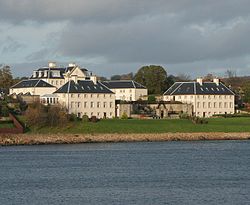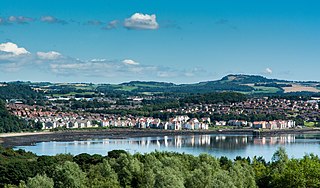
Dalgety Bay is a coastal town and parish in Fife, Scotland. According to Fife Council, the town is home to , making this the eighth-largest place in Fife. The civil parish has a population of 10,777.

The title Earl of Moray, Mormaer of Moray or King of Moray was originally held by the rulers of the Province of Moray, which existed from the 10th century with varying degrees of independence from the Kingdom of Alba to the south. Until 1130 the status of Moray's rulers was ambiguous and they were described in some sources as "mormaers", in others as "Kings of Moray", and in others as "Kings of Alba". The position was suppressed by David I of Scotland some time after his defeat of Óengus of Moray at the Battle of Stracathro in 1130, but was recreated as a feudal earldom by Robert the Bruce and granted to Thomas Randolph, 1st Earl of Moray in 1312.
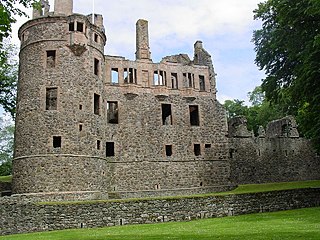
Huntly Castle is a ruined castle north of Huntly in Aberdeenshire, Scotland, where the rivers Deveron and Bogie meet. It was the ancestral home of the chief of Clan Gordon, Earl of Huntly. There have been four castles built on the site that have been referred to as Huntly Castle, Strathbogie Castle or Peel of Strathbogie.

Dalmeny House is a Gothic revival mansion located in an estate close to Dalmeny on the Firth of Forth, in the north-west of Edinburgh, Scotland. It was designed by William Wilkins, and completed in 1817. Dalmeny House is the home of the Earl and Countess of Rosebery. The house was the first in Scotland to be built in the Tudor Revival style. It provided more comfortable accommodation than the former ancestral residence, Barnbougle Castle, which still stands close by. Dalmeny today remains a private house, although it is open to the public during the summer months. The house is protected as a category A listed building, while the grounds are included in the Inventory of Gardens and Designed Landscapes in Scotland.

Doune Castle is a medieval stronghold near the village of Doune, in the Stirling council area of central Scotland and the historic county of Perthshire. The castle is sited on a wooded bend where the Ardoch Burn flows into the River Teith. It lies 8 miles northwest of Stirling, where the Teith flows into the River Forth. Upstream, 8 miles further northwest, the town of Callander lies at the edge of the Trossachs, on the fringe of the Scottish Highlands.
"The Bonnie Earl o' Moray" is a popular Scottish ballad, which may date from as early as the 17th century.

James Stewart, 2nd Lord Doune, 2nd Earl of Moray was a Scottish nobleman, the son of James Stewart, 1st Lord Doune and Margaret Campbell. He was murdered by George Gordon, Earl of Huntly as the culmination of a vendetta. Known as the Bonnie Earl for his good looks, he became the subject of a popular ballad, "The Bonnie Earl of Moray".

James Gillespie Graham was a Scottish architect, prominent in the early 19th century.
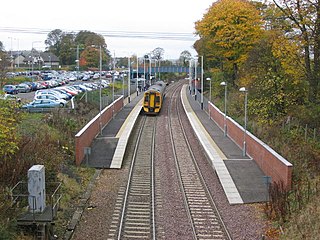
Dalgety Bay railway station serves the town of Dalgety Bay in Fife, Scotland. Lying on the Fife Circle and EdinburghーDundee lines, it is managed by ScotRail. It is currently the nearest railway station to Fordell Firs Camp site, the Scottish national headquarters for The Scout Association in Scotland, part of Scouting in Scotland.
Elizabeth Stewart, 2nd Countess of Moray suo jure, was the daughter of James Stewart, 1st Earl of Moray and Agnes Keith.

James Stuart, 4th Earl of Moray was a Scottish landowner.
James Stuart, 3rd Earl of Moray was the son of James Stewart, 2nd Earl of Moray and Elizabeth Stuart.
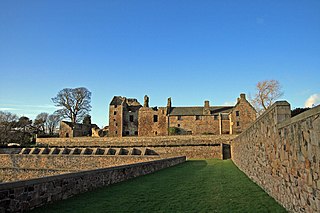
Aberdour Castle is in the village of Easter Aberdour, Fife, Scotland. Parts of the castle date from around 1200, making Aberdour one of the two oldest datable standing castles in Scotland, along with Castle Sween in Argyll, which was built at around the same time.

Balcarres House lies 1km north of the village of Colinsburgh, in the East Neuk of Fife, in eastern Scotland. It is centred on a mansion built in 1595 by John Lindsay (1552–1598), second son of David, 9th Earl of Crawford. The house became the family seat of the Earl of Crawford. The present house is the result of substantial extensions in the early nineteenth century, using part of a fortune made in India, but preserves much of the original mansion.
Events from the year 1592 in the Kingdom of Scotland.
Mary (Dudley) Sutton, Countess of Home (1586–1644), was a landowner, living in England and Scotland.
Simon Fraser, 6th Lord Lovat (1570–1633) was a Scottish courtier and landowner.
James Stewart, 1st Lord Doune (1529-1590) was a Scottish landowner.

The Downing Point Battery was a World War I coastal gun battery defending the Firth of Forth. The battery was constructed in 1914 at Downing Point, then part of the Earl of Moray's Donibristle Estate. The site is now situated within the new town of Dalgety Bay in Fife.
Margaret Home, Countess of Moray was a Scottish aristocrat.
